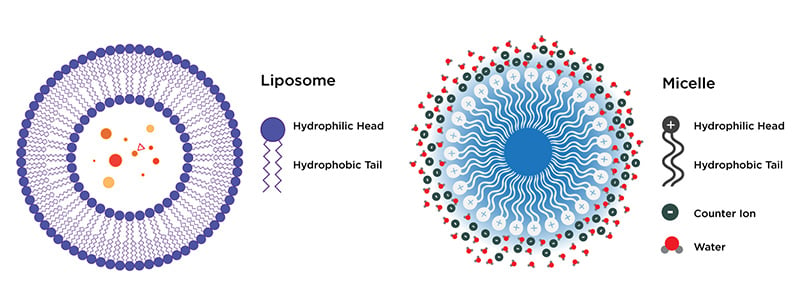Micelles
Delivering drugs and nutrients both artificially and naturally
Like liposomes, micelles can be viewed as simple models of the biological cell membrane—yet even simpler. Whereas a liposome consists of a closed, spherical lipid bilayer, a micelle is half of that: a closed (typically spherical) lipid monolayer. Rather than separate an inner aqueous environment from an outer, bulk aqueous phase (as does the liposome), the micelle's core consists of the hydrophobic fatty acid component of its own lipid molecules.

Although generally lacking the overall stability of liposomes within physiological environments, micelles have nonetheless been used successfully in drug delivery systems. Some commonly used applications include delivery of:
- Imaging agents for diagnostic applications
- Anticancer agents to treat tumors
- Drugs to treat neurodegenerative diseases
- Antifungal agents
- Polynucleotide therapeutics
- Protective nanoparticle packaging for delivering vaccines, including COVID-19 formulations BNT162b2 and mRNA-1237
Because micelles are typically far smaller (2–20 nm) than liposomes (up to several microns), they're not capable of carrying and delivering the same high volumes of nutrient or drug compounds achievable with liposomes. However, when used to contain smaller-volume, high-concentration formulations of lipophilic drugs (i.e., compatible with a hydrophobic core), polymeric micelles can actually penetrate target tissue (e.g., tumors) more easily than liposomes to deliver a therapeutic dose.
In vivo inspiration
While laboratory-created micelles are of the most interest to drug developers and manufacturers, these have been inspired, in part, by naturally occurring micelles critical to the healthy functioning of the body. For example:
- Digestive absorption of fat-soluble vitamins (e.g., E, D, A and K) and carotenoids is a micelle-mediated process
- Bile contains micelles consisting of bile salts, phosphatidylcholine and cholesterol
- Absorption of fatty acids and monoglycerides occurs when these molecules form micelles that facilitate their diffusion through intestinal cell membranes

